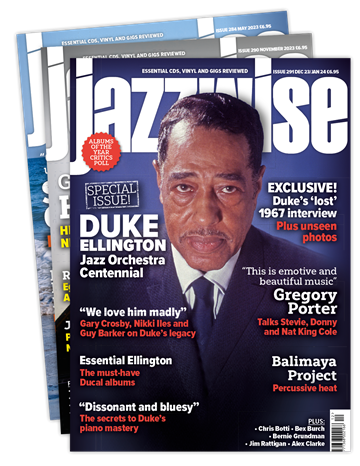Don Ellis: Three Classic Albums Plus How Time Passes/New Ideas/Essence/Mingus Dynasty
Author: Stuart Nicholson
View record and artist detailsRecord and Artist Details
Tears of Joy & Connection
Musicians: |
Don Ellis (t) |
Label: |
BGO |
Magazine Review Date: |
May/2018 |
Catalogue Number: |
BGOCD1317 |
RecordDate: |
1971 and 1972 |
Musicians: |
Charlie Persip (d) |
Label: |
Avid Jazz |
Magazine Review Date: |
May/2018 |
Catalogue Number: |
AMSC 1279 |
RecordDate: |
1959, 1960, 1961 |
On the 1950s and early 1960s New York jazz scene it seemed as if the word ‘ubiquity’ had been invented to describe Don Ellis. An able instrumentalist and conceptualist, he was as much at home in big bands (Ray McKinley, Charlie Barnet, Maynard Ferguson) as all manner of smaller ensembles including those led by George Russell and Charles Mingus. He had studied serial and aleatory techniques (he later renounced them); Indian and Near Eastern rhythms; was associated with the avant-garde and was perhaps the only ‘modern’ musician to appreciate the Indian summer of Henry ‘Red’ Allen, then playing the New York clubs, calling him the “most avant-garde player in New York”. Ellis left a series of albums on the Candid and New Jazz labels in his wake during his NYC period, of which How Times Passes, New Ideas and Essence (1960-61) are good examples – How Time Passes and New Ideas previously re-released by Fresh Sound in 2015. On Essence we hear him experimenting with rhythms such as 7/8 and 11/8; on New Ideas he is using periods of static harmony and on ‘Despair to Hope’ he is using indeterminacy inspired by John Cage, while ‘Tragedy’ is an atonal ballad. On How TimePasses, the piece ‘Improvisational Suite #1’ uses a 12-tone row. And, for good measure, he pops up on the classic Mingus Dynasty, which includes the four tracks on which he played. In the mid-1960s he studied classical techniques at UCLA on the West Coast, where he would later teach. There he formed a big band that specialised in super-complicated time signatures that recorded for Pacific Jazz. It soon gathered an enthusiastic West Coast following and was signed by Columbia, for whom his output was uneven, nothing quite making the impact of his debut album on the label Electric Bath and its major track ‘Indian Lady’. By the time of the first album on the BGO set – Tears of Joy from 1971 – he had got past his somewhat garrulous and excitable experiments with electronics, instead adding a string quartet to the band, presumably on a sink-or-swim basis. However, while the album is uneven – there are some ‘period pieces’ that don't stand the test of time – it does have its post-Kenton moments of maximum decibel excitement. The thing with Ellis' repertoire was that when a piece was good, it was very good, and when it wasn't, it was awful – there seemed no middle ground. By 1972's Connection, the string quartet had sunk without trace. The album's title traded on his Grammy-winning celebrity for supplying the soundtrack for motion picture The French Connection, and again the Ellis law of good/bad prevails. For example, ‘Theme from the French Connection’ is actually better than the film soundtrack, but some awful covers of songs by the likes of Gilbert O'Sullivan and Carole King bring things back down to terra firma with a bump.

Jazzwise Full Club
- Latest print and digital issues
- Digital archive since 1997
- Download tracks from bonus compilation albums throughout the year
- Reviews Database access
From £9.08 / month
Subscribe
Jazzwise Digital Club
- Latest digital issues
- Digital archive since 1997
- Download tracks from bonus compilation albums during the year
- Reviews Database access

